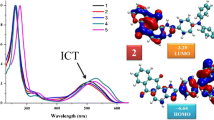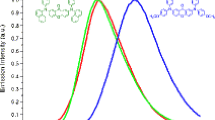Abstract
1,10-Phenanthroline-based luminescent materials play an important role as an excellent class of optoelectronic materials due to their remarkable and novel attributes for optoelectronic applications. There is an enormous demand of luminescent materials in many fields. The foremost objective of this paper is to synthesize fluorescent derivatives of 1,10-phenanthroline. The electronic effect of the substituents on the heteroaromatic ligand has been reviewed in solid state. These ligands were characterized by electrochemical study and spectroscopically. The value of energy band gap is estimated to be 3.0–4.5 eV for synthesized compounds. Photophysical features were analyzed through photoluminescence spectrometer, which indicates a strong impact of the substituents on the photoluminescent properties of the phenanthroline ligand. Upon excitation in ultraviolet region, intense broad band appeared in emission spectra of synthesized compounds lie in visible region which is further supported by CIE color coordinates. The detailed explanation about the geometry and frontier molecular orbitals calculation was carried out with the help of Avogadro and ORCA software.







Similar content being viewed by others
References
P. Mahata, S.K. Mondal, D.K. Singha, P. Majee, Luminescent rare-earth-based MOFs as optical sensors. Dalt. Trans. 46, 301 (2017)
K.L. Wong, G.L. Law, Y.Y. Yang, W.T. Wong, A highly porous luminescent terbium-organic framework for reversible anion sensing. Adv. Mater. 18, 1051 (2006)
A.M. Kaczmarek, P. Van Der Voort, Chemical sensors based on nano-sized lanthanide-grafted periodic mesoporous organosilica hybrid materials. J. Mater. Chem. C. 7, 8109 (2019)
Y.X. Hu, G.W. Zhao, Y. Dong, Y.L. Lü, X. Li, D.Y. Zhang, New rhenium(I) complex with thiadiazole-annelated 1,10-phenanthroline for highly efficient phosphorescent OLEDs. Dye. Pigment. 137, 569 (2017)
K. Nehra, A. Dalal, A. Hooda, S. Bhagwan, R.K. Saini, B. Mari, S. Kumar, D. Singh, Lanthanides β-diketonate complexes as energy-efficient emissive materials: A review. J. Mol. Struct. 1249, 131531 (2021)
A. Kumar, R. Srivastava, S.S. Bawa, D. Singh, K. Singh, G. Chauhan, I. Singh, M.N. Kamalasanan, White organic light emitting diodes based on DCM dye sandwiched in 2-methyl-8-hydroxyquinolinolatolithium. J. Lumin. 130, 1516 (2010)
X. Li, J. Gu, Z. Zhou, L. Ma, Y. Tang, J. Gao, Q. Wang, New lanthanide ternary complex system in electrospun nanofibers: Assembly, physico-chemical property and sensor application. Chem. Eng. J. 358, 67 (2019)
L.S. Hung, C.H. Chen, Recent progress of molecular organic electroluminescent materials and devices. Mater. Sci. Eng. R Reports. 39, 143 (2002)
H. Song, C. Fan, R. Wang, Z. Wang, S. Pu, 1,10-Phenanthroline decorated with substituent groups forming europium(III) complexes: synthesis, crystal structure, photoluminescence properties and their bioimaging in living cells. J. Coord. Chem. 73, 2311 (2020)
S.I. Weissman, Intramolecular energy transfer the fluorescence of complexes of Europium. J. Chem. Phys. 10, 214 (1942)
G. Yahioglu, P. Sammes, 1–10-Phenanthroline: A Versatile Ligand. Chem. Soc. Rev. 23, 327 (1972)
A. Bencini, V. Lippolis, 1,10-Phenanthroline: A versatile building block for the construction of ligands for various purposes. Coord. Chem. Rev. 254, 2096 (2010)
G. Accorsi, A. Listorti, K. Yoosaf, N. Armaroli, 1,10-Phenanthrolines: Versatile building blocks for luminescent molecules, materials and metal complexes. Chem. Soc. Rev. 38, 1690 (2009)
L.I. Blinova, V.A. Ilichev, R.V. Rumyantsev, G.K. Fukin, M.N. Bochkarev, Synthesis, structure, and luminescent properties of lanthanide complexes containing 1,10-phenanthroline and perfluorinated 2-mercaptobenzothiazolate ligands. Russ. Chem. Bull. 67, 1261 (2018)
H. Gallardo, G. Conte, A.J. Bortoluzzi, I.H. Bechtold, A. Pereira, W.G. Quirino, C. Legnani, M. Cremona, Synthesis, structural characterization, and photo and electroluminescence of a novel terbium(III) complex: {Tris(acetylacetonate) [1,2,5]thiadiazolo[3,4- f][1,10]phenanthroline}terbium(III). Inorganica Chim. Acta. 365, 152 (2011)
D. Singh, S. Bhagwan, A. Dalal, K. Nehra, R.K. Saini, K. Singh, A.P. Simantilleke, S. Kumar, I. Singh, Oxide ancillary ligand-based europium β-diketonate complexes and their enhanced luminosity. Rare Met. 40, 2873 (2021)
D. Singh, S. Bhagwan, A. Dalal, K. Nehra, K. Singh, A. Simantilleke, S. Kumar, I. Singh, Intense red luminescent materials of ternary Eu3+ complexes of oxide ligands for electroluminescent display devices. Optik Stuttg 208, 164111 (2020)
Y. Saitoh, T.A. Koizumi, K. Osakada, T. Yamamoto, Preparation of symmetric dibromides of 1,10-phenanthroline. Can. J. Chem. 75, 1336 (1997)
D. Výprachtický, D. Kaňková, V. Pokorná, I. Kmínek, V. Dzhabarov, V. Cimrová, Novel and simple synthesis of brominated 1,10-phenanthrolines. Aust. J. Chem. 67, 915 (2014)
Y. Saitoh, T. Yamamoto, Preparation and Properties of π -Conjugated Poly(1,10-phenanthroline-3,8-diyl). Chem. Lett. 24, 785 (1995)
W. Zeng, Y. Cao, Y. Bai, Y. Wang, Y. Shi, M. Zhang, F. Wang, C. Pan, P. Wang, Efficient dye-sensitized solar cells with an organic photosensitizer featuring orderly conjugated ethylenedioxythiophene and dithienosilole blocks. Chem. Mater. 22, 1915 (2010)
S.S. Zhu, T.M. Swager, Conducting polymetallorotaxanes: Metal ion mediated enhancements in conductivity and charge localization. J. Am. Chem. Soc. 119, 12568 (1997)
A. Dalal, K. Nehra, A. Hooda, D. Singh, R.S. Malik, S. Kumar, Synthesis and optoelectronic features of 5,5’-Bis(3,4-(ethylenedioxy)thien-2-yl)-2,2’-bipyridine. Optik 248, 167942 (2021)
E.F. Mooney, The infrared spectra of chloro- and bromobenzene derivatives-I. Anisoles and phenetoles. Spectrochim. Acta. 19, 877 (1963)
J. Coates, Interpretation of infrared spectra, a practical approach. Encycl. Anal. Chem. (2006). https://doi.org/10.1002/9780470027318.a5606
G. Kister, G. Cassanas, M. Vert, Morphology of poly(glycolic acid) by IR and Raman spectroscopies. Spectrochim. Acta Part A Mol. Biomol. Spectrosc. 53, 1399 (1997)
C.N.R. Rao, R. Venkataraghavan, T.R. Kasturi, Contribution To The Infrared Spectra Of Organosulphur Compounds. Can. J. Chem. 42, 36 (1964)
X.Y. Chen, X. Yang, B.J. Holliday, Photoluminescent europium-containing inner sphere conducting metallopolymer. J. Am. Chem. Soc. 130, 1546 (2008)
D. Singh, K. Nehra, R.K. Saini, A. Dalal, S. Bhagwan, K. Singh, A.P. Simantilleke, S. Kumar, Luminescence intensification of terbium(III) ion complexes with dipivaloylmethane (tmhd) and monodentate auxiliary ligands. Optik (Stuttg) 206, 164338 (2020)
D. Singh, S. Bhagwan, A. Dalal, K. Nehra, R.K. Saini, K. Singh, S. Kumar, I. Singh, Synthesis and investigation of enhanced luminescence of Ln(III)-complexes containing fluorinated β-diketone and oxygen donor ancillary ligands for efficient advanced displays. J. Lumin. 223, 117255 (2020)
C.S. McCamy, Correlated color temperature as an explicit function of chromaticity coordinates. Color Res. Appl. 17, 142 (1992)
I. Gupta, S. Singh, S. Bhagwan, D. Singh, Rare earth (RE) doped phosphors and their emerging applications: A review. Ceram. Int. 47, 19282 (2021)
S. Middya, A. Layek, A. Dey, P.P. Ray, Synthesis of nanocrystalline FeS2 with increased band gap for solar energy harvesting. J. Mater. Sci. Technol. 30, 770 (2014)
Y. Wang, Z. Liang, J. Qin, J. Tong, P. Guo, X. Cao, J. Li, Y. Xia, An Alcohol-Soluble Polymer Electron Transport Layer Based on Perylene Diimide Derivatives for Polymer Solar Cells. IEEE J. Photovoltaics. 9, 1678 (2019)
N.G. Tsierkezos, Cyclic voltammetric studies of ferrocene in nonaqueous solvents in the temperature range from 248.15 to 298.15 K. J. Solution Chem. 36, 289 (2007)
M.D. Hanwell, D.E. Curtis, D.C. Lonie, T. Vandermeerschd, E. Zurek, G.R. Hutchison, Avogadro: An advanced semantic chemical editor, visualization, and analysis platform. J. Cheminform. 4, 1 (2012)
F. Neese, The ORCA program system. Wiley Interdiscip. Rev. Comput. Mol. Sci. 2, 73 (2012)
T. Koopmans, Über die Zuordnung von Wellenfunktionen und Eigenwerten zu den Einzelnen Elektronen Eines Atoms. Physica. 1, 104 (1934)
R. Vijayaraj, V. Subramanian, P.K. Chattaraj, Comparison of global reactivity descriptors calculated using various density functionals: A QSAR perspective. J. Chem. Theory Comput. 5, 2744 (2009)
Acknowledgements
The authors wish to show appreciation to [EMR/2016/006135] from the SERB-DST, New Delhi, for the financial assistance and also Author (KN) wish to extend special thanks to UGC-New Delhi for JRF [DEC18-114381] fellowship.
Author information
Authors and Affiliations
Corresponding author
Additional information
Publisher's Note
Springer Nature remains neutral with regard to jurisdictional claims in published maps and institutional affiliations.
Supplementary Information
Below is the link to the electronic supplementary material.
Rights and permissions
About this article
Cite this article
Nehra, K., Dalal, A., Hooda, A. et al. Spectroscopic and optoelectronic investigations of 3,8-bis(3,4-(ethylenedioxy)thien-2-yl)-1,10-phenanthroline. J Mater Sci: Mater Electron 33, 115–125 (2022). https://doi.org/10.1007/s10854-021-07268-5
Received:
Accepted:
Published:
Issue Date:
DOI: https://doi.org/10.1007/s10854-021-07268-5




